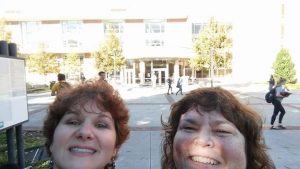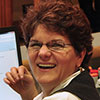This article is more than 5 years old.
I attended three different conferences this fall, Designing Libraries IV: Designing 21st Century Libraries at North Carolina State University, NCLA in Greensboro and the Access Services Conference in Atlanta, GA. In order to be most succinct, I’m combining posts for all three, though the subject matter ranged quite extensively.
The Designing Libraries conference was chock full of libraries telling the stories of what they did to be prepared for the academic library’s reinvention as place. The presentations are all available online. Story after story of how each library made significant changes to their space that had historically held books. Library leaders, planners and their architects conducted panel discussions from “Creating the Vision,” to “Designing Great Library Environments for Staff,” and “The Role of Makerspaces in Academic Libraries.” Thematically, all of the various speakers identified the importance of making spaces that are flexible, making space for the study and collaboration needs of today’s student, and the need to hire experts to ensure that you will do it right. Renovation is not for the faint of heart.
At NCLA, I presented in two different sessions. The first one on “Developing and Entrepreneurial Library Culture” along with Mary Scanlon and Mary Krautter (of UNCG) was delivered to a very full room. The presentation was one we pared down from the fuller workshop we’d delivered in Abu Dhabi last spring. The audience participated in a lively discussion after the presentation was done. The second session I participated in was one entitled “A Library for the Whole Student: Creating a Multidimensional Culture of Health & Wellness at your Library” along with Meghan Webb, Susan Smith and Hu Womack. We discussed the 9 dimensions of wellness described by our Thrive office, and how the library has partnered in creating initiatives to help. Interestingly, one of the questions asked was about how our “Cans for Fines” program works wherein students can bring in canned goods to eliminate overdue fines from their record. I am continually surprised how things that are so embedded in our culture here are ground breaking ideas elsewhere.
It is rare when one goes to a conference wherein every session is relevant, but that is actually true with The Access Services Conference, held in Atlanta, GA from November 11-13. The featured keynote speaker was Peter Bromberg, a very dynamic speaker with a terrific message about how difficult it is for us to continue to adapt to the pace of change when change is increasing exponentially. He used this great and very funny video to illustrate his point entitled “Everything’s Amazing and Nobody’s Happy.” Do yourself a favor and take a few minutes to watch it. Other sessions I attended were focused on staff training to maximize customer service, creating a reserve textbook collection, and on using student feedback to redefine library spaces. Much of what was related were ideas we’ve already implemented, so that at least reassured me that we are on the right path. Ellen Makaravage and I took a field trip to tour the Georgia Tech Info Commons. That space was actually highlighted as one of the examples in the first conference and takes me full circle back to that designing 21st century libraries idea.

3 Comments on ‘Three Conferences = Busy Autumn’
Thanks for posting, Mary Beth! I’ve heard lots of talk about the Info Commons at Georgia Tech! I need to go take a look when I’m home for the holidays! It was great to be part of the panel with you and Susan and Meghan at NCLA!
Busy fall for you!
Thanks for boiling it all down so succinctly for us — I know the details will show up in brainstorming and planning meetings!